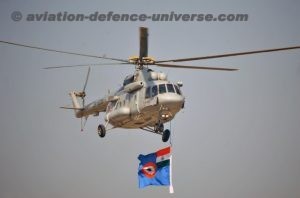By Richard Johnston, Director, International Business Development, Air Mobility & Maritime Missions, Lockheed Martin
Bethesda, Maryland, USA. 04 October 2020. History was made in India and the defense industry when in 2008, the Government of India announced its purchase of six C-130J Super Hercules airlifters — a $1.2 billion acquisition through India’s first Foreign Military Sale acquisition.
These first six Super Hercules were delivered to the Indian Air Force’s (IAF) No. 77 Squadron (“Veiled Vipers”) stationed at Air Force Station Hindon on or ahead of schedule between 2010 and 2011.
India received six additional C-130Js in 2017, operated out of Air Force Station Arjan Singh by No. 87 Squadron, “The Raptors.” This was also a Foreign Military Sale between the Government of India and the U.S. government.
The C-130J is the most advanced production model of the legendary C-130 Hercules mid-sized tactical airlifter, built by U.S.-based Lockheed Martin. Like its namesake, the Hercules is known for its ability to support many tasks and missions in the most challenging of conditions. The C-130J incorporates all of the unmatched performance traits and capabilities found in its core design and amplifies them to new levels of technology, capability and reliability with the advanced C-130J.
To date, there is no aircraft in history, production or operation that can match the C-130J. There are now 25 operators in 21 nations that fly or will fly the C-130J, with India’s fleet being one of the most famous and well-known Super Herc fleets around the world.
Just as India’s C-130J purchase made history, a few years later, an IAF crew used one of those same C-130Js to set a new record.
In August 2013, a crew from the No. 77 Squadron landed one of these C-130Js at Daulat Beg Oldie in Ladakh, a small airstrip in the Himalayans that has the distinction of being the highest (at 16,614 ft./5,000m) — and most challenging — runways in the world. This feat was a record for the IAF, which beat its own world record for high altitude operations, and for the C-130 and the C-130J, both of which claimed upwards of 100 world records in its 60 years of production.
Aside from setting world records, India’s C-130Js have been used to support a variety of missions over the past few years, to include: humanitarian aid, natural disaster support (numerous floods; and an IAF C-130J was the first aircraft to land and extend support during the Nepal earthquake), airlift, search and rescue, and special operations.
The Indian Air Force‘s C-130J Super Hercules have a highly integrated and sophisticated configuration primarily designed to support India’s special operations requirement. Equipped with an Infrared Detection Set (IDS), the aircraft can perform precision low-level flying, airdrops and landing in blackout conditions. Self-protection systems and other features are included to ensure aircraft survivability in hostile air defense environments. The aircraft also are equipped with air-to-air receiver refueling capability for extended range operations.
The C-130J provides the Indian Air Force with a proven airlift solution that can truly deliver results for many different mission requirements. The C-130J’s capabilities can be expanded to support other critical future needs, to include tanking, search and rescue, and border patrol/security surveillance.
While 12 C-130Js support IAF crews in a multitude of missions, India’s connection to the C-130 isn’t just through its Super Hercules operations. Since 2011, all new-production C-130Js have been built with components that are made in India – another great example of the “Make in India” concept in practice.
Tata Lockheed Martin Aerostructures Limited (TLMAL) is a joint venture established in 2010 between Tata Advanced Systems Limited (TASL) and Lockheed Martin Aeroframe Corporation located in Hyderabad, India.
TLMAL began producing C-130J Super Hercules airframe components in late 2011.
TLMAL not only exemplifies the Government of India’s “Make in India” objectives, but it has the distinction of being the single global source of C-130J empennage assemblies included on all new Super Hercules aircraft produced at Lockheed Martin’s aeronautics site in Marietta, Georgia, USA. To date, TLMAL has manufactured 130 C-130J empennages.
In fact, TLMAL is increasing the indigenization of C-130 manufacturing in Hyderabad by transitioning the production of approximately 2,000 previously imported empennage parts to Tata Sikorsky Aerospace, Ltd. (TSAL) thereby further supporting the “Atma Nirbhar Bharat” abhiyaan of the Government of India. These parts were previously manufactured by suppliers located outside of India.
Empennage assemblies produced by TLMAL include the aircraft’s horizontal and vertical stabilizers along with leading edges and tip assemblies.
In April 2018, TLMAL inaugurated India’s first-of-its-kind metal-to-metal bonding facility the Hyderabad facility. The new 4,700 square-meter metal-to-metal bonding facility added a new cutting-edge capability to the Indian aerospace industry and enabled Tata Sikorsky Aerospace, Ltd. (TSAL) — another Tata-Lockheed Martin joint venture in India — to use this technology across manufacturing programmes for complex aerostructures manufacturing and increased indigenisation, which directly supports the Government of India’s “Make in India” initiative. More than 80 skilled employees work in this facility, which can expand to support future work.
The new facility and capacity expansion created new job opportunities for skilled workers in India’s manufacturing sector and provide on-the-job training, which incidentally also supports the Government of India’s “Skills India” initiative.
It can be said that while C-130Js are flown by operators around the world, they have the distinction of having their roots in India.





























































































































